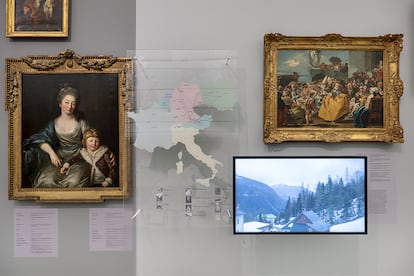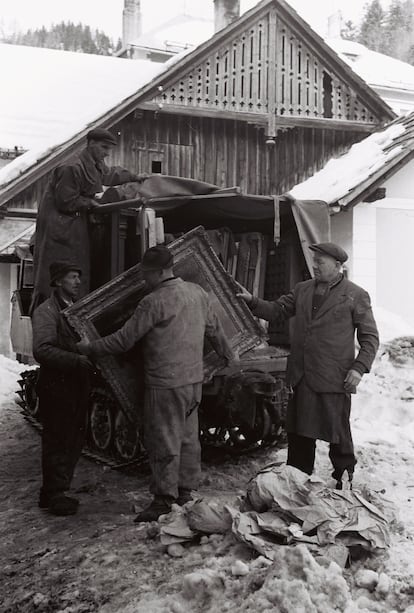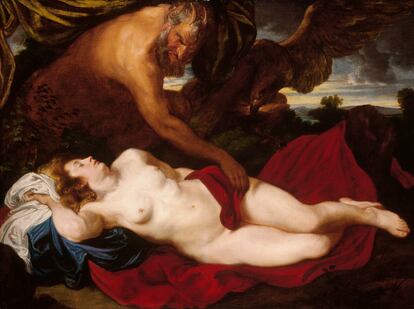Everything is captivating in the Salzkammergut. In this alpine region where adorable towns like Hallstatt, old growth forests, lakes and the Dachstein glacier flourish, the Nazis hid a treasure of almost 10,000 works of art underground. A total of 1,428 pieces came from the most important national museums in Austria, such as the Belvedere, the Albertina and the Museum of Art History in Vienna, but the majority were works looted in Europe occupied by the Third Reich with which Hitler planned the megalomaniacal Führer Museum in Linz.
The occurrence was the result of necessity. Art had to be saved from Allied bombing and they chose the last bastion of Nazi resistance in the Alps. They loaded artillery tractor-trailers with works by Vermeer, Rembrandt, Tintoretto, Pieter Brueghel the Elder; with sculptures like The Madonna of Bruges, sculpted in marble by Michelangelo, who left Belgium wrapped in mattresses; with The adoration of the Mystical Lamb, a medieval polyptych by Jan van Eyck looted from Ghent Cathedral, and transported during the snows of the winter of 1943 to the catacombs of the Altaussee salt mine. The following year they moved the masterpieces from the Viennese museums to the Lauffen salt mine. Hitler’s strategy had worked and the head of Patrimony in Vienna copied the idea. Now the Lentos art museum in Linz has managed to collect more than 80 of these works, including pieces by Goya, Titian and Liebermann and artists degenerates like Munch and Corinth, to exhibit them in the exhibition The journey of paintings.
The exact place where they were hidden in the Altaussee mine, 140 kilometers from Linz, can still be visited. The scenario has not changed anything. George Clooney rescued the event in Monuments Men, a willful entertainment film with a budget of 70 million euros that appropriates real events so that History works as in an episode of Team A. The poster for the film hangs paradoxically on a wall in the Lentos. The true outcome is perhaps too twisted to be credible on film: the region’s Nazi leader, gauleiter and obergruppenführer of the SS August Eigruber, ordered eight sealed wooden boxes with the letterhead “Caution / Marble” to be installed next to the vermeer and company. Inside they housed half a ton of explosives each. They were well camouflaged. Along with the 6,500 paintings, 130 sculptures, 120 tapestries and 480 drawings, there were another 1,700 wooden boxes with antiquarian books. Their intention was to explode them inside the mine if things got ugly, which they did.

The miners were alarmed. It is not just any deposit. It was the main source of wealth for the Habsburgs and today it remains active as the most important salt mine in Austria, 50 tons of salt are extracted from its bowels every hour. Behind the Anschluss, the monopoly of this production was controlled from Berlin. The workers sensed that along with the works of art, the great economic wealth of the region was in danger and, in desperation, they clung to a Nazi burning nail: Ernst Kaltenbrunner, the head of the Gestapo, who was hiding with his lover in a nearby villa. Kaltenbrunner intervened to help him and on the night of May 4, 1945, the miners removed the bombs and hid them in the forest until the arrival of the US Army on May 8. Eigruber was hanged for his responsibility in the crimes committed in Mauthausen and its satellite camps. Kaltenbrunner, too.
The exhibition at the Lentos is part of an ambitious exhibition trilogy linked to the European capital of culture of Bad Ischl in 2024. The second exhibition is presented in Bad Aussee and is dedicated to the art dealer Wolfgang Gurlitt (1888-1965), an unscrupulous speculator during Nazism. A gray, chiaroscuro character points out with paternalism in the exhibition. He traded, trafficked and did business with the Nazis while he used his partner and Jewish common-law wife Lilly Agoston as a front man—and saved his life. The daring method he found to free Agoston from the gas chamber was a marriage of convenience with a young man from Denmark, which allowed them both to have a Danish passport to trade degenerate art in exchange for fresh foreign currency for the Reich. . Always harassed by creditors and by a hedonistic lifestyle, his house was bought by his wife and his ex-wife with his own money (he lived with the three of them, to the confusion of the family’s visits). high society). He never allowed his daughters to work because, he said, “a Gurlitt doesn’t work.” He was the representative of Picasso, Liebermann, Schiele, Klimt and Kokoschka. With the latter, an artist persecuted by the Nazis who narrowly escaped the extermination camp, he had a close friendship. Gurlitt was the first to exhibit his work again in Austria in 1949, well supported by pieces by Klimt, Schiele and Kubin.

By now Gurlitt was the owner of an infamous number of works that had belonged to Jewish collectors and that came into his hands in indecipherable form during the Second World War. When his residence and art gallery in Berlin were destroyed in an Allied bombing raid in November 1943, one of the reasons he moved from greater Berlin to provincial Bad Aussee, where he today stars this exhibition at the Kammerhofmuseum, was to take advantage of the Aryanization of Jewish mansions. Her collection is the origin of the Lentos, the capital museum of Linz, which changed its name in 2003. The original was the New Linz City Gallery-Wolfgang Gurlitt Museum. For now, 12 paintings from Gurlitt’s collection that were acquired by the city of Linz have been returned to his rightful heirs. Among them, the valuable portrait of Ria Munk by Klimtwhich until 2009 was exhibited in the museum.
“A dandy who worked to fill the Führer Museum with works of art,” says Michael John, an expert on art looted during the Third Reich and who was consulted in the Munk family trial. John is leading the reopening of the Bad Ischl city museum, announced for July, one of the city’s star actions as European Capital of Culture. The museum will have a Biedermeier aesthetic name and façade reminiscent of filmmaker Wes Anderson’s sets: Hotel Austria.

Lauffen, on the outskirts of Bad Ischl, was chosen to host the latest exhibition because the second salt mine used as an art bunker was located here. “But besides Hitler’s art theft, another important aspect is the looting of works of art which is in full swing even today. This is a task that Europe must urgently confront,” says Elisabeth Schweeger, artistic director of the cultural capital of Bad Ischl. With this approach, it is inaugurated The life of things. Looted – Displaced – Rescuedwhich addresses state-planned art theft and expropriations (“Aryanizations”) under the German Reich, and examines, guided by the work of 14 contemporary artists, colonial exploitation in the Democratic Republic of the Congo, plunder in Iraq or cultural destruction in Lebanon.
The three exhibitions dedicated to Nazi looted art and the Hotel Austria can be visited throughout the summer. They will coincide on the Salzkammergut agenda with traditional proposals such as the Bad Goisern Chamois Hair Plume Olympics.
All the culture that goes with you awaits you here.
Subscribe
Babelia
The literary news analyzed by the best critics in our weekly newsletter
RECEIVE IT
Subscribe to continue reading
Read without limits
_
#Hitlers #unfathomable #legacy #looter #works #art